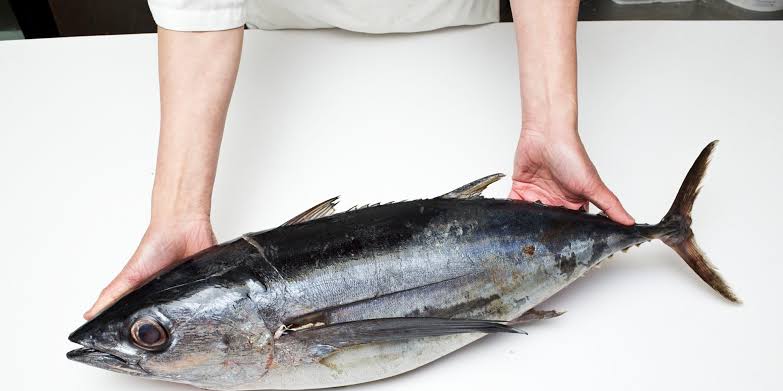Tuna is a saltwater fish that belongs to the family Scombridae, which also includes mackerel, bonito, and other species. It is a popular seafood worldwide, known for its firm, meaty texture and mild flavor.
Tuna is a source of lean protein and is rich in omega-3 fatty acids, which are beneficial for heart health. It is also a good source of vitamins and minerals such as vitamin D, selenium, and potassium.
There are several species of tuna, including albacore, bluefin, skipjack, and yellowfin. Each species has its unique characteristics and culinary uses.
Tuna can be prepared in various ways, such as grilled, baked, or canned. It is commonly used in dishes like sushi, salads, and sandwiches. However, due to concerns about overfishing and mercury contamination, it is important to choose sustainably sourced and low-mercury options when consuming tuna.
Read Also: Health Benefits and Uses of Shrimp
Description of Tuna

Tuna is a large saltwater fish with a streamlined, torpedo-shaped body that is designed for fast swimming. Its body is covered in small, smooth scales, and it has a pointed head with a sharp, protruding jaw. Tuna can range in size from several pounds to over 1,000 pounds, depending on the species.
Tuna species vary in color, but many have a dark blue or blackish-blue back, silver sides, and a white belly. They are powerful swimmers and are known for their speed and endurance. Tuna are often found in large schools, and they migrate long distances in search of food and warmer water.
Tuna is a popular food fish and is valued for its meat, which is firm, dense, and has a rich, meaty flavor. The color of the meat can range from light pink to dark red, depending on the species and the part of the fish. The high oil content of tuna meat makes it a good source of omega-3 fatty acids, which are important for heart and brain health.
Health Benefits of Tuna

Below are potential health benefits of consuming tuna:
Rich in protein: Tuna is a high-protein food, which is essential for building and repairing tissues in the body.
Good source of omega-3 fatty acids: Tuna is rich in omega-3 fatty acids, which are important for brain function, heart health, and reducing inflammation in the body.
May reduce the risk of heart disease: The omega-3 fatty acids in tuna may help reduce the risk of heart disease by lowering cholesterol levels and reducing inflammation.
May improve brain function: Omega-3 fatty acids in tuna may improve brain function and help reduce the risk of cognitive decline and dementia.
May reduce the risk of certain cancers: Tuna contains selenium, which has been linked to a reduced risk of certain types of cancer.
Good source of vitamin D: Tuna is a good source of vitamin D, which is important for bone health, immune function, and reducing the risk of certain diseases.
May improve eye health: Tuna contains high levels of omega-3 fatty acids, which may help reduce the risk of age-related macular degeneration.
May help with weight loss: Tuna is a low-calorie, high-protein food that may help promote weight loss and reduce body fat.
May improve skin health: The omega-3 fatty acids in tuna may help improve skin health by reducing inflammation and promoting skin elasticity.
May help reduce inflammation: Tuna contains anti-inflammatory compounds, which may help reduce inflammation in the body and reduce the risk of chronic diseases.
May improve mood: Omega-3 fatty acids in tuna may help improve mood and reduce symptoms of depression and anxiety.
May improve sleep quality: Tuna contains tryptophan, an amino acid that may help improve sleep quality.
May help reduce the risk of autoimmune diseases: Tuna contains vitamin D, which has been linked to a reduced risk of autoimmune diseases.
May improve bone health: Tuna is a good source of vitamin D, which is important for bone health and reducing the risk of osteoporosis.
May help with arthritis: Tuna contains anti-inflammatory compounds, which may help reduce inflammation in the joints and improve symptoms of arthritis.
May improve fertility: Tuna is a good source of selenium, which may help improve fertility in both men and women.
May reduce the risk of type 2 diabetes: Tuna contains omega-3 fatty acids, which may help improve insulin sensitivity and reduce the risk of type 2 diabetes.
Uses of Tuna

Tuna is a versatile fish that can be used in a variety of dishes. Below are some common uses of tuna:
Sushi and sashimi: Tuna is a popular fish used in sushi and sashimi dishes. Its meaty texture and rich flavor make it a favorite among sushi lovers.
Grilled or baked: Tuna can be grilled or baked and served as a main dish. Its firm flesh holds up well to cooking and can be seasoned with a variety of spices and herbs.
Canned tuna: Tuna is commonly available in canned form, which is a convenient and affordable way to enjoy this nutritious fish. Canned tuna can be used in sandwiches, salads, and casseroles.
Tuna salad: Tuna salad is a classic dish that combines canned tuna with mayonnaise, celery, and other ingredients. It can be served as a sandwich or as a side dish.
Tuna steaks: Tuna steaks are thick cuts of tuna that are often grilled or seared. They can be served as a main dish with a side of vegetables or rice.
Tuna melt: A tuna melt is a sandwich that combines canned tuna with melted cheese and bread. It is often served hot and toasted.
Tuna pasta salad: Tuna pasta salad is a cold salad that combines cooked pasta with canned tuna, vegetables, and a dressing. It is a popular dish for picnics and potlucks.
Tuna casserole: Tuna casserole is a baked dish that combines canned tuna with pasta, vegetables, and a creamy sauce. It is a comfort food favorite that is easy to make and feeds a crowd.
Tuna tartare: Tuna tartare is a raw dish that combines diced tuna with avocado, soy sauce, and other seasonings. It is often served as an appetizer.
Tuna burgers: Tuna burgers are a healthy alternative to beef burgers. They are made with ground tuna, breadcrumbs, and seasonings, and can be grilled or pan-fried.
Read Also: Common Giant African Snail Species with their Unique Features and Characteristics
How to Prepare Tuna

Tuna can be prepared in a variety of ways, depending on your preference and the type of dish you are making. Here are some common methods of preparing tuna:
Grilled: Grilling is a popular way to prepare tuna steaks. Brush the tuna with oil and season with salt and pepper, then grill over high heat for 2-3 minutes per side, or until cooked to your desired level of doneness.
Pan-seared: Tuna can also be pan-seared on the stove. Heat a non-stick pan over medium-high heat, add oil, and place the tuna in the pan. Cook for 2-3 minutes per side, or until cooked through.
Broiled: Broiling is another option for cooking tuna steaks. Preheat the broiler, brush the tuna with oil, and season with salt and pepper. Place the tuna on a broiler pan and broil for 2-3 minutes per side, or until cooked to your liking.
Canned tuna: Canned tuna can be used in a variety of dishes, from tuna salad to casseroles. Drain the tuna and mix with your desired ingredients, such as mayonnaise, chopped celery, and spices.
Sashimi: Tuna can be served raw as sashimi. Make sure to use fresh, high-quality tuna that has been properly handled and stored. Slice the tuna into thin pieces and serve with soy sauce and wasabi.
Tuna burgers: Tuna burgers can be made by mixing ground tuna with breadcrumbs, egg, and seasonings. Shape into patties and grill or pan-fry until cooked through.
Tuna tartare: Tuna tartare is a raw dish that combines diced tuna with avocado, soy sauce, and other seasonings. Dice the tuna into small pieces and mix with the other ingredients.
When preparing tuna, it is important to choose high-quality fish that has been handled and stored properly to avoid foodborne illness. Additionally, be sure to follow cooking guidelines to ensure the fish is cooked to a safe temperature.

